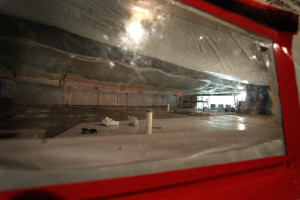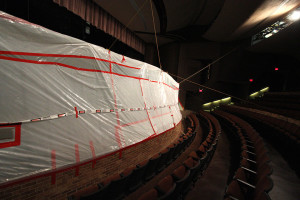
The replacement of the Fain Theatre stage floor has been hampered with delays after the discovery of asbestos within the glue holding the hard board to the plywood below. Even with the discovery of the asbestos, workers said the construction would be finished by the first day of classes. However, on Aug. 20 the construction was hit with another delay — substandard work — that will push back completion another two weeks.
David Percy, facilities director, said, “The quality of the floor installation was not good enough.”
Percy said the materials used were not up to the standard preferred for the stage floor. The empty space caused by spacing of the boards below the stage floor would have caused ripples that would affect sets built above it.
Eric Koger, associate professor of theater, said, “We choose better materials that will give us better options. I think now that they know that I am a point person to talk to about the stage, these problems won’t be an issue.”
The current contractors will finish encapsulating the asbestos and another company will install the floor. The initial bid to replace the flooring was $15,000 and the theater department received Higher Education Assistance Funding. The price increased to $43,000 after workers discovered the asbestos. With the hiring of a new company to install the floor, it is unsure if the cost will increase further, Percy said, but it is a possibility. This will be the third company hired to install the new floor.
The C wing of Fain Fine Arts opened in 1979, when using materials made of asbestos was seen as a safe practice. It was widely used because of its resistance to heat.
“Anything that’s built 15-20 years ago, there’s a chance that someone used asbestos materials. Certainly the buildings around here are 40-60 years old, so it was very common back then because they didn’t realize that it was a material that attacks your lungs,” Percy said.
Conventionally, workers replace stage floors every 10 to 15 years. This is the first time the Fain stage floor will be replaced since the theater was built in 1978.
Elizabeth Lewandowski, theater department chair, said, “It was just waiting until it just absolutely had to happen. It had gotten to the point where for a couple of years it was getting bad. We screw into that floor all the time, we’re rolling big pieces of scenery on it. It was literally coming up in chunks.”
The stage is made up of several layers. The intention was to remove and replace the top layer, the hard board until the workers found asbestos in the glue.
Percy said he has a binder in his office that lists buildings on campus that have been checked for asbestos.
“We paid a great deal of money and spent a number of years at Midwestern to go through and have materials checked in the buildings. Floor titles, any wall materials, carpet would be sent off to the lab to be checked,” Percy said.
Once demolition of the theater floor had started the black, workers found a glue-like substance containing asbestos.
Percy said,”This glue was not on the list. We know that sometimes it has asbestos in it so we immediately stopped demolition of the boards and we got our asbestos contractor in here. He took a sample and I think the next day he came back and told us there was asbestos. I guess they were not aware that there was a glue underneath the hardboard. This caught us a little by surprise but basically we know where materials might be where we would be exposed from a maintenance project.”

According to the United States Environmental Protection Agency, once asbestos has been identified work must be halted until paperwork is filed with the appropriate state agency. The school has to give the state at least two weeks notice indicating when the work will start.
Percy said, “We actually had to switch contractors to go one that wasn’t asbestos rated to a contractor who is asbestos rated. Of course, not only did they have to have the rating to work with it, they had to go in and completely encapsulate the entire area with sheeting that’s airtight and they draw a negative pressure on that area so any asbestos that does go airborne will not get in the building but be evacuated from the building.”
As part of the standard operating procedure with asbestos, the workers have to wear white suits and breathing filters as they complete their work. The contractors spray water in the air so if any dust is created it settles back to the ground. Despite the precautions the glue is not friable, or prone to crumbling, since it contains asbestos.
Percy said, “When you look at that you say ‘that’s pretty serious.’ It’s not very serious. It’s not one of the more serious situations. It’s not like you’re knocking asbestos containing ceiling tiles off and they’re crumbling and you’ve got all this dust flying all in the air. If you go over and watch, there’s very little dust created in this process.”
Instead of attempting to remove all of the asbestos workers will encapsulate it, because when asbestos is disturbed its toxins can be released into the air. It’s also more difficult to remove all of the asbestos because, “We would have to take off another layer and there’s no guarantee that there wouldn’t have been another layer of mastic below that layer of plywood,” Percy said.
The main theater is not used as a classroom space and does not impact any lectures. The delays will impact the theater department’s first production of the year, August: Osage County. The department usually works in the theater every afternoon from one to five working scenery, hanging lighting, building sets, etc. The week before classes, instructors moved auditions to the studio theater behind the main stage.
Lewandowski said,”Everyday that we are delayed access to our theater means another weekend day we’re going to have to come in to makeup that work. The faculty and the students who can’t get in there to work on a normal workday when we’re already scheduled to work in there can do some things elsewhere instead but then ultimately are going to have to come in to the theater on a weekend.”
















